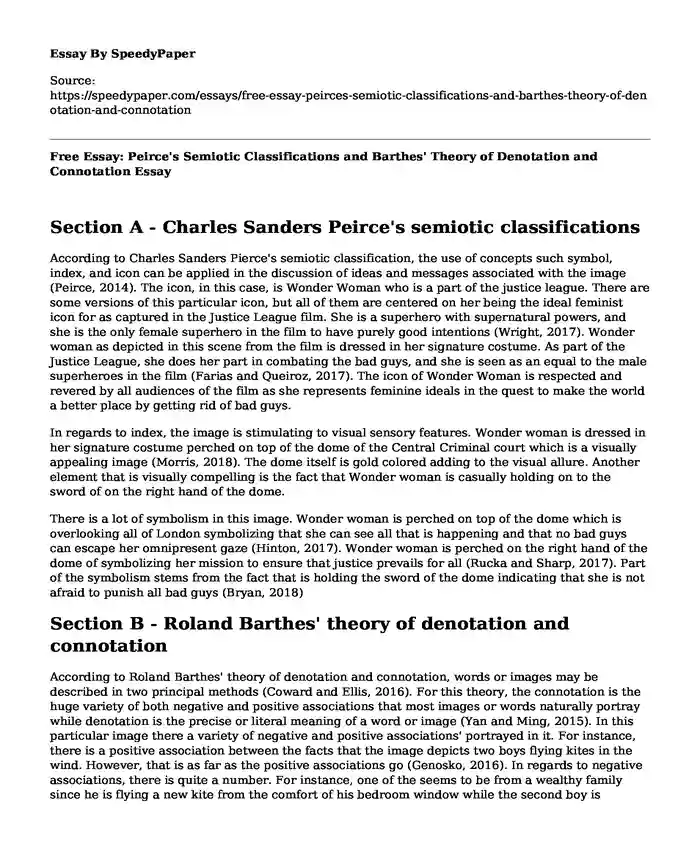Section A - Charles Sanders Peirce's semiotic classifications
According to Charles Sanders Pierce's semiotic classification, the use of concepts such symbol, index, and icon can be applied in the discussion of ideas and messages associated with the image (Peirce, 2014). The icon, in this case, is Wonder Woman who is a part of the justice league. There are some versions of this particular icon, but all of them are centered on her being the ideal feminist icon for as captured in the Justice League film. She is a superhero with supernatural powers, and she is the only female superhero in the film to have purely good intentions (Wright, 2017). Wonder woman as depicted in this scene from the film is dressed in her signature costume. As part of the Justice League, she does her part in combating the bad guys, and she is seen as an equal to the male superheroes in the film (Farias and Queiroz, 2017). The icon of Wonder Woman is respected and revered by all audiences of the film as she represents feminine ideals in the quest to make the world a better place by getting rid of bad guys.
In regards to index, the image is stimulating to visual sensory features. Wonder woman is dressed in her signature costume perched on top of the dome of the Central Criminal court which is a visually appealing image (Morris, 2018). The dome itself is gold colored adding to the visual allure. Another element that is visually compelling is the fact that Wonder woman is casually holding on to the sword of on the right hand of the dome.
There is a lot of symbolism in this image. Wonder woman is perched on top of the dome which is overlooking all of London symbolizing that she can see all that is happening and that no bad guys can escape her omnipresent gaze (Hinton, 2017). Wonder woman is perched on the right hand of the dome of symbolizing her mission to ensure that justice prevails for all (Rucka and Sharp, 2017). Part of the symbolism stems from the fact that is holding the sword of the dome indicating that she is not afraid to punish all bad guys (Bryan, 2018)
Section B - Roland Barthes' theory of denotation and connotation
According to Roland Barthes' theory of denotation and connotation, words or images may be described in two principal methods (Coward and Ellis, 2016). For this theory, the connotation is the huge variety of both negative and positive associations that most images or words naturally portray while denotation is the precise or literal meaning of a word or image (Yan and Ming, 2015). In this particular image there a variety of negative and positive associations' portrayed in it. For instance, there is a positive association between the facts that the image depicts two boys flying kites in the wind. However, that is as far as the positive associations go (Genosko, 2016). In regards to negative associations, there is quite a number. For instance, one of the seems to be from a wealthy family since he is flying a new kite from the comfort of his bedroom window while the second boy is homeless and dressed in tattered clothes flying an old and tattered kit from the street below in front of his cardboard box home (Zhang, 2017).
In regards to denotation, there is a lot that can be deduced from this image. For instance, the literal meaning of the image is that children have the same inherent nature regardless of their economic or social standing. Both the rich and the homeless kid are enjoying flying their kites in the wind. However, the rich kid has the convenience of flying a brand new kite right from inside his house while the homeless kid does not enjoy such pleasures.
References
Bryan, J. (2018). Wonder Woman: Feminist and economic icon. In Superheroes and Economics (pp. 25-37). Routledge.
Coward, R., & Ellis, J. (2016). Language and Materialism: Developments in Semiology and the Theory of the Subject. Routledge.
Genosko, G. (2016). Critical semiotics: Theory, from information to affect. Bloomsbury Publishing.
Hinton, A. L. (2017). Wonder Woman, the Gutter, and Critical Genocide Studies. Memory and Genocide: On What Remains and the Possibility of Representation, 165-174.
Morris, H. (2018). Wonder Woman's Fight For Autonomy: How Patty Jenkins Did What No Man Could.
Peirce, C. S. (2014). Charles Sanders Peirce. Information Theory, 181.
Rucka, G., & Sharp, L. (2017). Wonder Woman Vol. 1: The Lies. Dc Comics.
Wright, J. L. (2017). Becoming a (Wonder) Woman: Feminism, Nationalism, and the Ambiguity of Female Identity. Wonder Woman and Philosophy: The Amazonian Mystique, 3-18.
Yan, S., & Ming, F. (2015). Reinterpreting some key concepts in Barthes theory. Journal of Media and Communication Studies, 7(3), 59-66.
Zhang, S. (2017). Meaning-Centrism in Roland Barthes' Structuralism. Chinese Semiotic Studies, 13(3), 219-227.
Cite this page
Free Essay: Peirce's Semiotic Classifications and Barthes' Theory of Denotation and Connotation. (2022, Jul 18). Retrieved from https://speedypaper.net/essays/free-essay-peirces-semiotic-classifications-and-barthes-theory-of-denotation-and-connotation
Request Removal
If you are the original author of this essay and no longer wish to have it published on the SpeedyPaper website, please click below to request its removal:
- Free Essay on Writing Inspiration: Joseph Considered Himself a Writer
- Negative Effects of Advertising on Youth, Essay Example
- Collaborative Consumption Essay Example
- Free Essay about Cultural Sensitivity and Health Care
- Free Essay on Using Naloxegol for Treating Opioid-induced Constipation
- Free Essay: The Role of Social Media and the Internet in High School
- Why Do People Take Drugs? - Essay Sample
Popular categories





